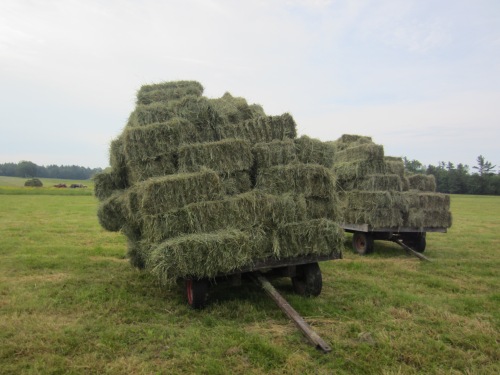Summer is officially here. I know this not because of yesterday’s Summer Solstice, nor the weeklong sun and heat, but because my house was invaded by its usual summer swarm: The Browns. The swarm descends the minute the first tractor hits the hay fields to mow and does not leave until the last bale is put up in the barn. This can take anywhere from six weeks to three months, depending on the weather.
The Queen of the swarm, my mother-in-law, often brings sweet delicacies with her that lure us into her hive. On the first day of arrival this year, she brought buttery Ranger Cookies made with oatmeal, Rice Krispies, and a cup of butter. It is true what they say about how to attract bees.
The Brown Family is a friendly swarm who land on this place not to decimate like locusts, but to help with the chore that takes as much help as possible: haying. There are three types of haying that we do here on LongMeadows Farm — square bales, round bales, and silage bales.

Mostly empty barn waiting to be filled. Hay from last year means that we don’t have to bale as much.
We have yet to come into the 21st Century with the first type of haying: square baling. Most farms now have equipment that stacks the hay on a trailer, and a machine that also helps to unload in the barn. We have one of the Browns or a close facsimile standing on the back of a trailer, grabbing each bale as it exits the baler, and stacking each sometimes eight or nine high. When it is 90 degrees and humid, this is the most dreaded job (at least in my mind) or the best if you are looking to sweat off a few pounds. My sister-in-law warned me never to learn it, because once I did I would actually have to DO IT. I took her advice. I learned to drive the tractor instead. No hay scratches all over my body that way.
Until, that is, we unload.
As long as the hay doesn’t fall into the middle of the road causing a haypocolypse with oncoming traffic, the trailer is pulled into the barn and unloaded by two, three, or sometimes four people — depending on where it needs to be stacked. The farthest reaches of the barn often call for someone to toss off the trailer to a middle person who then tosses it to a person standing high in the hay who then stacks it.
The barn holds 5500 bales, this year we are shooting for 4000. We have 350 done.
**SIDE NOTE: For those new to “haying” the most important thing to remember is NOT to stack wet bales of hay. These bales heat up and could combust bringing the entire barn down in flames. This is not a rural myth, it is true. I have stuck my hand in the middle of a bale that has heated up to uncomfortable levels and started to turn black from scorching. CRAZY, right?!?
The next two type of haying is the least labor intensive: round bales. After the hay has been mowed, tedded (flipped to dry), and raked (put into windrows for baling) it only takes one person (usually my husband) to drive around and bale the hay. While not physically exhausting, this can be time-consuming. We are aiming for 100 of these. At this time, our count is 0.
The last type is the most fun to watch at the end stages: silage bales. These are the “white marshmallow” bales that you may see on the side of the road during the summer. Silage is nutritionally-rich, fermented hay that smells God awful. In the winter, my husband sometimes spills just tiny bits of the stuff on him after opening a bale, and I have to immediately banish him to the outside to strip. Yes, winter. Yes, Maine. Yes, it smells that bad. Even the smallest amounts fills the space with the acrid smell of vomit. Cows love the stuff. It makes me wonder about them. It does.
Silage bales take the round bales one step further. One person spears a bale with a tractor, drives it to the wrapper, and the other wraps. Check out this video of how it works. My sister thinks this looks like a fun carnival ride. I have to agree. The silage bale count is 23. We want 70.
A few of the worker bees will be back today for more haying fun. I’ll let you know the count later.

